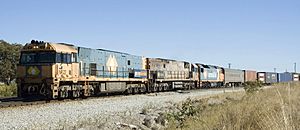Sydney–Perth rail corridor facts for kids

The Sydney–Perth rail corridor is a very long railway line in Australia. It stretches for about 4,352 kilometers (2,704 miles) from Sydney in New South Wales all the way to Perth in Western Australia. Most of this important railway is managed by the Australian Rail Track Corporation.
This railway line is super busy! It carries a huge amount of freight across Australia. As of 2008, it moved 81% of all land freight between the eastern states and Perth. This was a big jump from 60% in 1996–97. In November 2007, a record 3.46 billion gross tonne-kilometers of freight was carried. As of 2022, big companies like Pacific National, Aurizon, and SCT Logistics use this corridor to move goods.
Passenger Trains on the Corridor
The Indian Pacific is a famous passenger train that travels the entire Sydney–Perth route. It's a special trip that usually takes three days. It's not just for getting from one place to another, but for enjoying the journey and seeing the country.
Another well-known train, The Ghan, uses part of this corridor. It travels from Adelaide to Tarcoola before heading north to Darwin. There are also some local passenger trains that run at the Sydney and Perth ends of the line. However, there are no local passenger services in the central part of the route, in South Australia.
How the Railway Was Built
Before 1970, traveling across Australia by train was tricky. Different states used different railway track widths. This meant that passengers and goods had to be moved from one train to another at certain stations. This process is called "trans-shipping." It happened at places like Broken Hill, Port Pirie, and Kalgoorlie.
Here's how the different lines connected (from east to west):
- The New South Wales Government had a standard-gauge line from Sydney to Broken Hill, which opened in 1927.
- Then, the Silverton Tramway Company had a short, narrow-gauge line from Broken Hill to Cockburn. This line opened in 1888.
- The South Australian Government had a narrow-gauge line from Cockburn to Port Pirie, finished in 1888.
- The Australian federal government built a standard-gauge line from Port Pirie to Port Augusta, opened in 1937. This connected to the Trans-Australian Railway, which was also standard-gauge. The Trans-Australian Railway opened in 1917 and was a huge project after Australia became a federation.
- Finally, the Western Australian Government had a narrow-gauge line called the Eastern Goldfields Railway from Kalgoorlie to Perth, opened in 1897.
In 1970, all these different lines were converted to a single standard gauge. This made it much easier for trains to travel all the way from Sydney to Perth without stopping to transfer goods or people.


